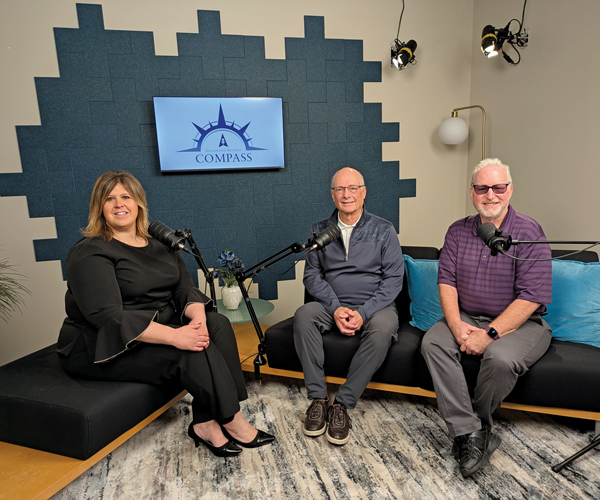Westfield Bank is the picture of a well-established community bank that has been serving customers for generations. The first branch occupies an 1836 building that once served as a post office for the Medina County village of Westfield Center. Next door is the home office of its founder, Westfield Insurance, a massive red-brick complex featuring an original building modeled after the stately Governor’s Palace in Colonial Williamsburg, Virginia.
A short drive away, in the village of Seville, a glassy 40,000-square-foot operations center houses 110 of the bank’s 190 employees. The rest of the employees work at seven branches in five counties and in addition to Westfield Center, include locations from Brecksville to Wooster to Canton.
According to Westfield Bank president Mike Toth, the institution is the 11th-largest of the 177 community banks headquartered in the state of Ohio with approximately $1.5 billion in assets. For 39 consecutive quarters (almost 10 years) it has earned a five-star rating from independent rating agency Bauer Financial.
The bank opened a mere 18 years ago, in 2001, with $11 million in seed money from the insurance company and a dozen employees. Toth credits its success to the skillful marriage of online/mobile-banking technology with traditional bank-branch service.
“Many of the traditional community banks have the branches, but they don’t have the technology,” he observes. “But they care significantly about serving their clients and providing that very personal touch. Some of the larger banks have invested more heavily in the digital capabilities. Westfield Bank has the technology to compete with the large regional banks or national banks but also the focus on customer service and providing a great experience through our branches. So it’s a really nice mix.”
Westfield Insurance executives decided to establish a community bank to diversify the company’s revenue stream and, as Toth puts it, “find ways to deepen relationships with existing clients” after Congress passed the Financial Services Modernization Act of 1999. The law, among other things, repealed a 1933 counterpart prohibiting institutions from simultaneously offering commercial banking, investment banking and insurance services. Westfield Bank actually opened in a double-wide trailer installed at the back of the insurance-company parking lot until renovations to the aforementioned former post office were completed in 2003.
“We were starting from zero,” Toth says with a chuckle.
Among the bank’s early customers were Westfield Insurance’s independent agents. The company began depositing its annual profit sharing in free accounts, most of which the agents opted to maintain.
“Now we have the ability to better serve those agencies through the financial solutions that we provide to them,” Toth says. “If you have an insurance agent looking to sell their agency, our team can provide financing to the purchaser of that agency. It becomes a win-win for both the buyer and the seller.”
Although the trailer certainly wasn’t the ideal office space, the low cost of maintaining it allowed the bank to offer better deals to customers.
“If you have a more rational number of bank branches and don’t have the fixed costs associated with real estate, then you can in turn extend those savings back to your clients in the form of higher [interest] rates [on deposits] or lower fees,” Toth explains.
He adds that, unlike some competitors, the bank always maintained a conservative approach in determining when and where to open a location or retain one obtained in an acquisition. And the absence of an attractive place to impress and woo clients sent account executives, many of whom were Medina County natives with long-established relationships in the community, out in the field to meet potential commercial clients on their turf.
But the fledgling entity truly set itself apart from its competitors by investing in the technology needed to participate in the emerging internet banking trend. In late 2003, the Check Clearing for the 21st Century Act was signed into law, allowing financial institutions to process a scanned electronic image of a check. Westfield Bank, unencumbered by investments in myriad branches and ATMs, began providing commercial customers with the remote deposit capture technology needed to scan checks and deposit them electronically, complete with installation of and training on the device, free of charge.
“Some of it was the opportunity and the recognition that the technology should be embraced quicker,” Toth says of the motivation. “And some of it was the reality that in order to compete, [we] had to have an eye toward leveraging the technology available in the market.”
The bank continued to build on that technological cornerstone. In 2012, it increased in size and expanded its brick-and-mortar presence in the market with the acquisition of Western Reserve Bank, a community bank with $185 million in assets and branches in Medina, Brecksville and Fairlawn. Two years later, it acquired Valley Savings Bank, another community bank with $130 million in assets and two branches in Cuyahoga Falls that Westfield Bank recently consolidated into one State Road location. And, in late 2016, the bank invested almost $7 million in the purchase and renovation of the Seville operations center, a former Panther trucking facility. Around the same time, a small loan-production office opened in Mansfield.
Toth says the bank is continuously striving to improve the online/mobile experience. He notes that one of the bank’s greatest challenges is determining just exactly when clients are ready to adopt technological advances.
“People embrace technology at different rates and have a higher level of comfort more quickly than others,” he observes. Timing a rollout right is difficult.
“We talk about a lot of different ideas on a regular basis,” he says. “And then we’ll generally go off and do some research to try to understand client needs, client demand, and develop a point of view on how quickly the market is to embrace that particular technology.”
At the branches, employees are cross-trained as “universal bankers” who can perform a range of services, from making a deposit to opening a new account to taking a loan application. The practice reduces wait times for clients.
Bankers in the private banking division, established in 2017, cater to the personal banking needs of business and consumer clients. Toth points out that the bank bases access to such services, at least in part, on the complexity of a financial situation rather than solely on income, investible dollars and/or net worth.
“Sometimes there are clients who have a need for more personalized interaction with a banker but may not have the financial assets today,” he explains. He gives the physician who just completed his or her residency and the new law-firm partner as examples.
In 2015, Westfield Bank chairman and CEO Jon Park stated a goal of doubling the bank’s then approximately $1 billion in assets by 2020. Toth confirms the goal still exists. But he insists it will be met profitably and sustainably, whether by acquiring new customers or competitors.
“We’re looking to continue to grow, which could include geographic growth,” he adds. “But we intend to stay true to our Northeast Ohio focus.”




